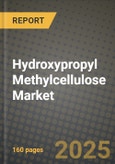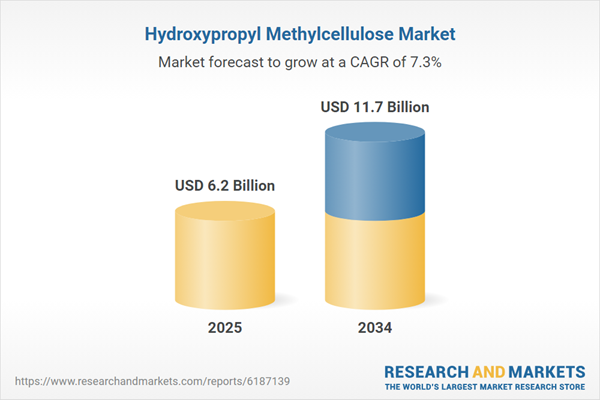Hydroxypropyl Methylcellulose (HPMC) is a versatile cellulose derivative widely used across multiple industries, including construction, pharmaceuticals, personal care, and food. As a water-soluble polymer, HPMC provides valuable functional properties such as thickening, stabilizing, film-forming, and water retention. These attributes make it an essential additive in various applications, including tile adhesives, coatings, tablets, and cosmetics. The global HPMC market has experienced consistent growth due to rising demand for eco-friendly and non-toxic ingredients, coupled with the expanding construction and pharmaceutical sectors. Additionally, the shift toward sustainable and renewable raw materials has positioned HPMC as a favored alternative in formulations that require enhanced performance and environmental compatibility. Manufacturers are continuously innovating to improve product quality, while end-users seek high-performance solutions that offer both technical advantages and regulatory compliance.
The Hydroxypropyl Methylcellulose market witnessed notable advancements driven by increasing demand from the construction and pharmaceutical industries. Construction activities, particularly in emerging economies, surged as urbanization continued and infrastructure investments accelerated. This boosted the need for high-quality construction materials such as tile adhesives, self-leveling compounds, and mortars containing HPMC for improved workability and water retention. In pharmaceuticals, the trend toward sustained-release formulations and plant-based excipients pushed demand for premium-grade HPMC. Furthermore, manufacturers focused on optimizing production processes to enhance efficiency and reduce environmental impact. The use of renewable raw materials gained traction, while research efforts centered on developing innovative grades tailored for niche applications. Regulatory developments, including stricter guidelines for ingredient safety and environmental standards, also influenced product development and market dynamics.
The Hydroxypropyl Methylcellulose market is poised for further growth, driven by continued expansion in key end-use sectors and increasing emphasis on sustainability. The construction industry is expected to remain a major consumer of HPMC, as green building initiatives and advanced construction techniques gain momentum. In pharmaceuticals, ongoing innovation in drug delivery systems and a growing preference for plant-based excipients will support demand. Additionally, emerging applications in personal care and food products are likely to open new growth avenues. The market will see increased adoption of bio-based HPMC grades derived from sustainable cellulose sources, addressing both environmental concerns and regulatory requirements. As technology advances, manufacturers are anticipated to introduce new functional grades offering enhanced performance and broader application versatility. Overall, the Hydroxypropyl Methylcellulose market is set to benefit from a combination of industry expansion, regulatory alignment, and technological advancements, securing its place as a key ingredient in multiple markets.
Key Insights: Hydroxypropyl Methylcellulose Market
- Growing demand for plant-based and renewable HPMC grades to meet consumer and regulatory expectations for sustainable products.
- Increased focus on developing specialty HPMC grades tailored for high-performance applications in construction, pharmaceuticals, and personal care.
- Rising adoption of HPMC in green building materials and sustainable construction practices to enhance energy efficiency and environmental impact.
- Advances in production technologies, including bio-based synthesis methods, to improve efficiency and reduce carbon footprints.
- Integration of HPMC in innovative drug delivery systems, such as sustained-release tablets and transdermal patches, to improve therapeutic outcomes.
- Rapid growth in the construction industry, particularly in emerging markets, driving demand for HPMC-based building materials.
- Expanding pharmaceutical sector, with increasing use of HPMC in formulations due to its plant-based, safe, and functional properties.
- Consumer demand for eco-friendly and bio-based products in personal care, food, and industrial applications.
- Strict regulatory standards emphasizing the use of non-toxic, sustainable ingredients in various end-use industries.
- Fluctuating raw material prices and limited availability of sustainably sourced cellulose may impact production costs and hinder consistent supply.
Hydroxypropyl Methylcellulose Market Segmentation
By Product Types
- Pharmaceutical Grade
- Industrial Grade
By Sales Channel
- Direct Sale
- Indirect Sale
By End Use
- Construction
- Pharmaceuticals (Including Cosmetics)
- Food Industry
- Others End Uses
Key Companies Analysed
- Celotech Chemical Co Ltd.
- Zhejiang Kelain New Materials Co Ltd.
- Shin-Etsu Chemical Co Ltd
- Ashland Global Specialty Chemicals Inc
- DuPont de Nemours Inc
- Colorcon Inc
- Lotte Fine Chemical Co Ltd
- Shandong Head Co Ltd
- Shijiazhuang Shangdun Cellulose Co Ltd
- Fenchem Biotek Ltd
- Mitsubishi Chemical Group Corporation
- Paramount Chemical & Acid Corporation
- Universal Mine Chem
- Madhu Hydrocolloids Pvt. Ltd.
- Dow Chemical Company
- Ashland Global Holdings Inc.
- Samsung Fine Chemicals Co. Ltd.
- Zhejiang Kehong Chemical Co. Ltd.
- China Ruitai International Holdings Co. Ltd.
- Kingstone Chemical Holdings Co. Ltd.
- SE Tylose GmbH & Co. KG
- Daicel FineChem Ltd.
- Anhui Shanhe Pharmaceutical Holdings Co. Ltd.
- Ashland LLC
- Changzhou Guoyu Environmental S&T Co. Ltd.
- J. Rettenmaier & Söhne GmbH + Co KG
- Shanxi Sanwei Group Co. Ltd..
Hydroxypropyl Methylcellulose Market Analytics
The report employs rigorous tools, including Porter’s Five Forces, value chain mapping, and scenario-based modeling, to assess supply-demand dynamics. Cross-sector influences from parent, derived, and substitute markets are evaluated to identify risks and opportunities. Trade and pricing analytics provide an up-to-date view of international flows, including leading exporters, importers, and regional price trends.Macroeconomic indicators, policy frameworks such as carbon pricing and energy security strategies, and evolving consumer behavior are considered in forecasting scenarios. Recent deal flows, partnerships, and technology innovations are incorporated to assess their impact on future market performance.
Hydroxypropyl Methylcellulose Market Competitive Intelligence
The competitive landscape is mapped through proprietary frameworks, profiling leading companies with details on business models, product portfolios, financial performance, and strategic initiatives. Key developments such as mergers & acquisitions, technology collaborations, investment inflows, and regional expansions are analyzed for their competitive impact. The report also identifies emerging players and innovative startups contributing to market disruption.Regional insights highlight the most promising investment destinations, regulatory landscapes, and evolving partnerships across energy and industrial corridors.
Countries Covered
- North America - Hydroxypropyl Methylcellulose market data and outlook to 2034
- United States
- Canada
- Mexico
- Europe - Hydroxypropyl Methylcellulose market data and outlook to 2034
- Germany
- United Kingdom
- France
- Italy
- Spain
- BeNeLux
- Russia
- Sweden
- Asia-Pacific - Hydroxypropyl Methylcellulose market data and outlook to 2034
- China
- Japan
- India
- South Korea
- Australia
- Indonesia
- Malaysia
- Vietnam
- Middle East and Africa - Hydroxypropyl Methylcellulose market data and outlook to 2034
- Saudi Arabia
- South Africa
- Iran
- UAE
- Egypt
- South and Central America - Hydroxypropyl Methylcellulose market data and outlook to 2034
- Brazil
- Argentina
- Chile
- Peru
Research Methodology
This study combines primary inputs from industry experts across the Hydroxypropyl Methylcellulose value chain with secondary data from associations, government publications, trade databases, and company disclosures. Proprietary modeling techniques, including data triangulation, statistical correlation, and scenario planning, are applied to deliver reliable market sizing and forecasting.Key Questions Addressed
- What is the current and forecast market size of the Hydroxypropyl Methylcellulose industry at global, regional, and country levels?
- Which types, applications, and technologies present the highest growth potential?
- How are supply chains adapting to geopolitical and economic shocks?
- What role do policy frameworks, trade flows, and sustainability targets play in shaping demand?
- Who are the leading players, and how are their strategies evolving in the face of global uncertainty?
- Which regional “hotspots” and customer segments will outpace the market, and what go-to-market and partnership models best support entry and expansion?
- Where are the most investable opportunities - across technology roadmaps, sustainability-linked innovation, and M&A - and what is the best segment to invest over the next 3-5 years?
Your Key Takeaways from the Hydroxypropyl Methylcellulose Market Report
- Global Hydroxypropyl Methylcellulose market size and growth projections (CAGR), 2024-2034
- Impact of Russia-Ukraine, Israel-Palestine, and Hamas conflicts on Hydroxypropyl Methylcellulose trade, costs, and supply chains
- Hydroxypropyl Methylcellulose market size, share, and outlook across 5 regions and 27 countries, 2023-2034
- Hydroxypropyl Methylcellulose market size, CAGR, and market share of key products, applications, and end-user verticals, 2023-2034
- Short- and long-term Hydroxypropyl Methylcellulose market trends, drivers, restraints, and opportunities
- Porter’s Five Forces analysis, technological developments, and Hydroxypropyl Methylcellulose supply chain analysis
- Hydroxypropyl Methylcellulose trade analysis, Hydroxypropyl Methylcellulose market price analysis, and Hydroxypropyl Methylcellulose supply/demand dynamics
- Profiles of 5 leading companies - overview, key strategies, financials, and products
- Latest Hydroxypropyl Methylcellulose market news and developments
Additional Support
With the purchase of this report, you will receive:- An updated PDF report and an MS Excel data workbook containing all market tables and figures for easy analysis.
- 7-day post-sale analyst support for clarifications and in-scope supplementary data, ensuring the deliverable aligns precisely with your requirements.
- Complimentary report update to incorporate the latest available data and the impact of recent market developments.
This product will be delivered within 1-3 business days.
Table of Contents
Companies Mentioned
- Celotech Chemical Co Ltd.
- Zhejiang Kelain New Materials Co Ltd.
- Shin-Etsu Chemical Co Ltd.
- Ashland Global Specialty Chemicals Inc.
- DuPont de Nemours Inc.
- Colorcon Inc.
- Lotte Fine Chemical Co Ltd.
- Shandong Head Co Ltd.
- Shijiazhuang Shangdun Cellulose Co Ltd.
- Fenchem Biotek Ltd.
- Mitsubishi Chemical Group Corporation
- Paramount Chemical & Acid Corporation
- Universal Mine Chem
- Madhu Hydrocolloids Pvt. Ltd.
- Dow Chemical Company
- Ashland Global Holdings Inc.
- Samsung Fine Chemicals Co. Ltd.
- Zhejiang Kehong Chemical Co. Ltd.
- China Ruitai International Holdings Co. Ltd.
- Kingstone Chemical Holdings Co. Ltd.
- SE Tylose GmbH & Co. KG
- Daicel FineChem Ltd.
- Anhui Shanhe Pharmaceutical Holdings Co. Ltd.
- Ashland LLC
- Changzhou Guoyu Environmental S&T Co. Ltd.
- J. Rettenmaier & Söhne GmbH + Co KG
- Shanxi Sanwei Group Co. Ltd. .
Table Information
| Report Attribute | Details |
|---|---|
| No. of Pages | 160 |
| Published | October 2025 |
| Forecast Period | 2025 - 2034 |
| Estimated Market Value ( USD | $ 6.2 Billion |
| Forecasted Market Value ( USD | $ 11.7 Billion |
| Compound Annual Growth Rate | 7.3% |
| Regions Covered | Global |
| No. of Companies Mentioned | 27 |









